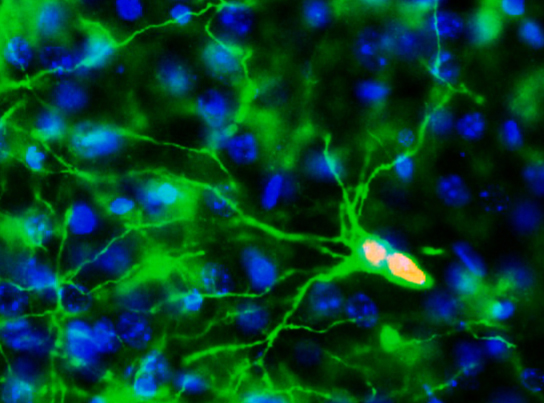Jean M. Hébert, Ph.D.
Professor, Dominick P. Purpura Department of Neuroscience Professor, Department of Genetics
(neuroscience category)

Devising methods of cell replacement for the adult neocortex when its cells are lost due to damage or age-related degeneration.
Generating and regenerating the neocortex
The Hébert lab has traditionally studied how the forebrain develops using conditional genetic methods in mice. Recently, the focus of the lab has transitioned to two new areas of interest. First, we are studying how homeostasis is maintained in the adult forebrain using primarily molecular genetic techniques to manipulate the expression of regulatory genes in neural stem and progenitor cells. Specifically, we are examining how neurogenesis is maintained in the hippocampus, how the myelination of axons is maintained through continuous oligodendrogenesis, and how cells become reactive to brain damage.
Second, we are devising novel methods to regenerate the damaged neocortex, the part of our brains that we use for our highest cognitive and perceptual functions. Neocortical damage can be local, due for example to stroke or trauma, or widespread, due for example to neurodegeneration or aging. Among the approaches we are taking, we are developing ways of replacing the principle neurons of the adult neocortex without significantly disrupting the function of existing neural circuits. These approches involve the use of mixed cell populations for transplantation and for widespread damage the use of cells that can disperse throughout the neocortex to repopulate and bolster existing neural circuits with new cells.

Selected Publications
Kamatkar N, Levy M, Hébert JM. (2019). Development of a monomeric inhibitory RNA aptamer specific for FGFR3 that acts as an activator when dimerized. Mol. Ther. Nuc. Acids, in press.
Kang W. Nguyen KCQ, Hébert JM. (2019). Transient redirection of SVZ-stem cells to oligodendrogenesis by FGFR activation promotes remyelination. Stem Cell Reports 12:1223-1231.
A recent blog: http://blogs.einstein.yu.edu/the-science-of-replacement-as-a-means-of-escaping-aging/
Hébert JM, Vijg J. (2018). Cell replacement to reverse brain aging: challenges, pitfalls, and opportunities. Trends in Neuroscience 41: 267-279.
Antoine MW, Zhu X, Dieterich M, Brandt T, Vijayakumar S, McKeehan N, Arezzo J, Zukin RS, Borkholder D, Jones SM, Frisina R, Hébert JM. (2018). Left-right brain lateralization in mammals due to early uneven ear input. PLoS Biology 16: e2002988.
Nandi S, Alvina K, Lituma PJ, Castillo PE, Hébert JM. (2018). Neurotrophin and FGF signaling adapter proteins, FRS2 and FRS3 regualte dentate granule cell maturation and exitatory synaptogenesis. Neuroscience 369: 192:201.
Nandi S, Gutin G, Blackwood CA, Kamatkar NG, Lee KW, Fishell G, Wang F, Goldfarb M, Hébert JM. (2017). Context-driven, receptor-dependent usage of an intracellular adapter governs specificity in FGF signal transduction. J. Neurosci. 37:5690-5698.
Antoine MW, Vijayakumar S, McKeehan N, Jones S, Hébert, JM. (2017). The severity of vestibular dysfunction in deafness as a determinant of comorbid hyperactivity or anxiety. J. Neurosci. 37: 5144-5154.
Andriani GA, Faggioli F, Baker D, Dollé MET, Sellers RS, Hébert JM, van Steeg H, Hoeijmakers J, Vijg J, Montagna C. (2016). Whole chromosome aneuploidy in the brain of BubR1H/H and Ercc1 -/Δ7 mice. Hum. Mol. Gen. 25: 755-765.
Nandi S, Chandramohan D, Fioriti L, Melnick AM, Hébert JM, Mason CE, Kandel ER, Rajasethupathy P. (2016). A role for piRNAs in retrotransposon silencing in the mammalian brain. P.N.A.S. U.S.A. 113: 12696-12702.
Kang W, Hébert JM. (2015). FGF signaling is necessary for neurogenesis in young mice and sufficient to reverse its decline in old mice. J. Neuroscience 35: 10217-10223.